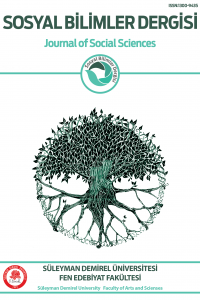Öz
Kendinden tiksinme, kendi kendine yöneltilen ve işlevsel olmayan bir bilişsel-duygusal şemadır (Powell vd. 2015). Overton vd. (2008) kendine yönelik tiksinmeyi ölçmek için Kendinden Tiksinme Ölçeğini (KTÖ) geliştirmişlerdir. Bu çalışmanın amacı, Türk kültüründe KTÖ’nün geçerliğini ve güvenirliğini belirlemektir. Ölçeğin yapı geçerliği analizleri için iki örneklem grubundan yararlanılmıştır. İlk grupta, 17-29 yaş aralığında 261 kişi (183 kadın, 73 erkek ve cinsiyetini belirtmeyen 5 kişi) bulunmaktadır. Bu grubun verilerine Açımlayıcı Faktör Analizi (AFA) yapılmıştır. İkinci grup, 17-31 yaş aralığında 284 kişiden (202 kadın, 77 erkek ve cinsiyetini belirtmeyen 5 kişi) oluşmaktadır. Bu grubun veri setine Doğrulayıcı Faktör Analizi (DFA) yapılmıştır. CFA sonuçları, tek faktörlü yapı için kabul edilebilir uyum iyiliği endekslerini göstermiştir. KTÖ’nün iç tutarlık güvenirlik Cronbach alfa katsayısı .78 ve ölçeğin test-tekrar test güvenirliği .72 olarak bulunmuştur. Bu çalışma, KTÖ’nün Türkiye’de yetişkinler üzerinde yeterli düzeyde geçerlik ve güvenirlik değerlerine sahip olduğunu göstermiştir.
Anahtar Kelimeler
Kaynakça
- Akça, S. (2018). Interpretative Phenomenological Analysis of Disgust in Traumatic Experience (Doctoral dissertation, METU). Anderson, L. M., Reilly, E. E., Thomas, J. J., Eddy, K. T., Franko, D. L., Hormes, J. M., & Anderson, D. A. (2018). Associations among fear, disgust, and eating pathology in undergraduate men and women. Appetite, 125, 445-453. doi.org/10.1016/j.appet.2018.02.017 Azlan, H. A., Overton, P. G., Simpson, J., & Powell, P. A. (2017). Effect of partners’ disgust responses on psychological wellbeing in cancer patients. Journal of clinical psychology in medical settings, 24(3-4), 355-364. doi.org/10.1007/s10880-017-9521-z Bahtiyar, B., & Yıldırım, A. (2019). Öz Tiksinme Ölçeği-Revize Formu: Türkçe uyarlama, geçerlik ve güvenirlik çalışması. Klinik Psikiyatri Dergisi, 22(3). DOI: 10.5505/kpd.2019.72692 Bhikram, T., Abi-Jaoude, E., & Sandor, P. (2017). OCD: obsessive–compulsive… disgust? The role of disgust in obsessive–compulsive disorder. Journal of psychiatry & neuroscience: JPN, 42(5), 300. Clarke, A., Simpson, J., & Varese, F. (2019). A systematic review of the clinical utility of the concept of self‐disgust. Clinical psychology & psychotherapy, 26(1), 110-134. doi.org/10.1002/cpp.2335 Curtis, V. (2011). Why disgust matters. Philosophical Transactions of the Royal Society B: Biological Sciences, 366(1583), 3478-3490. doi.org/10.1098/rstb.2011.0165 Curtis, V., Aunger, R., & Rabie, T. (2004). Evidence that disgust evolved to protect from risk of disease. Proceedings of the Royal Society of London. Series B: Biological Sciences, 271(suppl_4), S131-S133. doi.org/10.1098/rsbl.2003.0144 Davey, G. C., Buckland, G., Tantow, B., & Dallos, R. (1998). Disgust and eating disorders. European Eating Disorders Review: The Professional Journal of the Eating Disorders Association, 6(3), 201-211. doi.org/10.1002/(SICI)1099-0968(199809)6:3<201::AID-ERV224>3.0.CO;2-E Davey, G. C. (2011). Disgust: the disease-avoidance emotion and its dysfunctions. Philosophical Transactions of the Royal Society B: Biological Sciences, 366(1583), 3453-3465. doi.org/10.1098/rstb.2011.0039 Ekman, P. (1992). Are there basic emotions? Psychological Review, 99(3), 550–553. doi.org/10.1037/0033-295X.99.3.550 Gilbert, P. (2000). The relationship of shame, social anxiety and depression: The role of the evaluation of social rank. Clinical Psychology & Psychotherapy: An International Journal of Theory & Practice, 7(3), 174-189. doi.org/10.1002/1099-0879(200007)7:3<174::AID-CPP236>3.0.CO;2-U Gilbert, P., Durrant, R., & McEwan, K. (2006). Investigating relationships between perfectionism, forms and functions of self-criticism, and sensitivity to put-down. Personality and Individual Differences, 41(7), 1299-1308. doi.org/10.1016/j.paid.2006.05.004 Hu, L., & Bentler, P. M. (1999). Cutoff criteria for fit indexes in covariance structure analysis: Conventional criteria versus new alternatives. Structural Equation Modeling, 6, 1-55. doi:10.1080/10705519909540118. Izard, C. E. (2007). Basic emotions, natural kinds, emotion schemas, and a new paradigm. Perspectives on psychological science, 2(3), 260-280. doi.org/10.1111/j.1745-6916.2007.00044.x Mataix‐Cols, D., An, S. K., Lawrence, N. S., Caseras, X., Speckens, A., Giampietro, V., ... & Phillips, M. L. (2008). Individual differences in disgust sensitivity modulate neural responses to aversive/disgusting stimuli. European Journal of Neuroscience, 27(11), 3050-3058. doi.org/10.1111/j.1460-9568.2008.06311.x Olatunji, B. O., & Broman-Fulks, J. J. (2007). A taxometric study of the latent structure of disgust sensitivity: Converging evidence for dimensionality. Psychological Assessment, 19(4), 437. doi.org/10.1037/1040-3590.19.4.437 Orcan, F., (2018). Exploratory and Confirmatory Factor Analysis: Which One to Use First? Journal of Measurement and Evaluation in Education and Psychology, 9 (4), 414-421. doi: 10.21031/epod.394323 Overton, P. G., Markland, F. E., Taggart, H. S., Bagshaw, G. L., & Simpson, J. (2008). Self-disgust mediates the relationship between dysfunctional cognitions and depressive symptomatology. Emotion, 8(3), 379. doi.org/10.1037/1528-3542.8.3.379 Powell, P. A., Overton, P. G., & Simpson, J. (2014). The revolting self: An interpretative phenomenological analysis of the experience of self‐disgust in females with depressive symptoms. Journal of Clinical Psychology, 70(6), 562-578. doi.org/10.1002/jclp.22049 Powell, P. A., Simpson, J., & Overton, P. G. (2013). When disgust leads to dysphoria: A three-wave longitudinal study assessing the temporal relationship between self-disgust and depressive symptoms. Cognition & Emotion, 27(5), 900-913.doi.org/10.1080/02699931.2013.767223 Powell, P. A., Simpson, J., & Overton, P. G. (2015). An introduction to the revolting self: Self-disgust as an emotion schema. The revolting self: Perspectives on the psychological, social, and clinical implications of self-directed disgust, 1-24. Power, M. J., & Dalgleish, T. (2008). Cognition and emotion: From order to disorder (2e éd.). Power, M. J., & Tarsia, M. (2007). Basic and complex emotions in depression and anxiety. Clinical Psychology & Psychotherapy, 14(1), 19-31. doi.org/10.1002/cpp.515 Robins, R. W., & Schriber, R. A. (2009). The self‐conscious emotions: How are they experienced, expressed, and assessed?. Social and Personality Psychology Compass, 3(6), 887-898. doi.org/10.1111/j.1751-9004.2009.00217.x Simpson, J., Hillman, R., Crawford, T., & Overton, P. G. (2010). Self-esteem and self-disgust both mediate the relationship between dysfunctional cognitions and depressive symptoms. Motivation and Emotion, 34(4), 399-406. doi.org/10.1007/s11031-010-9189-2 Smith, N. B., Steele, A. M., Weitzman, M. L., Trueba, A. F., & Meuret, A. E. (2015). Investigating the role of self-disgust in nonsuicidal self-injury. Archives of Suicide Research, 19(1), 60-74.doi.org/10.1080/13811118.2013.850135 Surguladze, S. A., El-Hage, W., Dalgleish, T., Radua, J., Gohier, B., & Phillips, M. L. (2010). Depression is associated with increased sensitivity to signals of disgust: a functional magnetic resonance imaging study. Journal of psychiatric research, 44(14), 894-902. doi.org/10.1016/j.jpsychires.2010.02.010
Ayrıntılar
| Birincil Dil | Türkçe |
|---|---|
| Bölüm | psikoloji |
| Yazarlar | |
| Yayımlanma Tarihi | 31 Ağustos 2020 |
| Yayımlandığı Sayı | Yıl 2020 Sayı: 50 |
Kaynak Göster
Süleyman Demirel Üniversitesi Fen-Edebiyat Fakültesi Sosyal Bilimler Dergisi


